人教初一英语教案
- 格式:docx
- 大小:27.27 KB
- 文档页数:37

人教版初一英语上册教案15篇人教版初一英语上册教案【篇1】教学年级:七年级课程名称:Unit 3 Why do you like koalas?教材版本:人民教育出版社授课时间:40分钟(一)学生分析:1.本班学生对学习英语较感兴趣,能积极参加各种调查、采访、表演等实践活动。
2.学生学习动机明确,学习态度积极主动,能主动与他人合作,相互帮助,共同完成学习任务,遇到问题敢于主动向老师和同学请教,能大胆用英语交流。
(二)教材分析:本课时的内容是义务教育课程标准实验教科书英语新目标“Go for it!”七年级的《Unit 3 Why do you like koalas?》第一课时,主要话题是学习动物名称,并讨论喜好某种动物的原因。
通过话题的讨论喜欢动物的原因,增强了动物名称的词汇量,还增强课堂学习趣味性。
(三)教学目标语言知识目标1.学习有关动物的名词:tiger elephant koala dolphin panda lion penguin giraffe2.学习并运用品质的.形容词:cute smart shy ugly clever beautiful friendly quiet lazy来描述动物.3.掌握下列句型Why do you like…?. Because they’re….使学生熟练表达喜好并陈述原因。
语言能力目标1.学生能熟练谈论自己喜爱的动物并给出理由。
2.学生的口语和书面表达能力得到提高。
3.培养学生主动参与语言实践活动的能力,在游戏和小组竞赛中培养学生乐于表达、勇于展示自我的能力,从而树立学习英语的信心,获取成功的喜悦。
情感目标1.通过学习要培养学生自觉保护动物的意识。
2.培养学生积极参与,发扬团队合作的精神和竞争意识。
(四)教学策略1、教学方法Task-based, Language Teaching,途径:Guesing game, group work, pair work, survey, Internet teaching.2、教学辅助手段采用多媒体电脑投影图片,充分利用网络教材资源,扩大学生的知识面,激发学生的兴趣和求知欲。
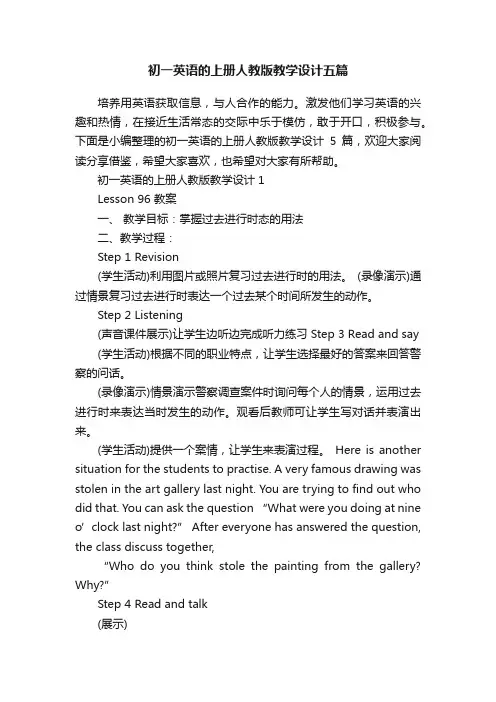
初一英语的上册人教版教学设计五篇培养用英语获取信息,与人合作的能力。
激发他们学习英语的兴趣和热情,在接近生活常态的交际中乐于模仿,敢于开口,积极参与。
下面是小编整理的初一英语的上册人教版教学设计5篇,欢迎大家阅读分享借鉴,希望大家喜欢,也希望对大家有所帮助。
初一英语的上册人教版教学设计1Lesson 96 教案一、教学目标:掌握过去进行时态的用法二、教学过程:Step 1 Revision(学生活动)利用图片或照片复习过去进行时的用法。
(录像演示)通过情景复习过去进行时表达一个过去某个时间所发生的动作。
Step 2 Listening(声音课件展示)让学生边听边完成听力练习 Step 3 Read and say (学生活动)根据不同的职业特点,让学生选择最好的答案来回答警察的问话。
(录像演示)情景演示警察调查案件时询问每个人的情景,运用过去进行时来表达当时发生的动作。
观看后教师可让学生写对话并表演出来。
(学生活动)提供一个案情,让学生来表演过程。
Here is another situation for the students to practise. A very famous drawing was stolen in the art gallery last night. You are trying to find out who did that. You can ask the question “What were you doing at nine o’clock last night?” After everyo ne has answered the question, the class discuss together,“Who do you think stole the painting from the gallery? Why?”Step 4 Read and talk(展示)Read the table about what David was doing at different times yesterday, then ask and answer in pairs.(录像演示)情景演示询问过去某个时间点正在进行的动作,看后让学生进行模仿练习。
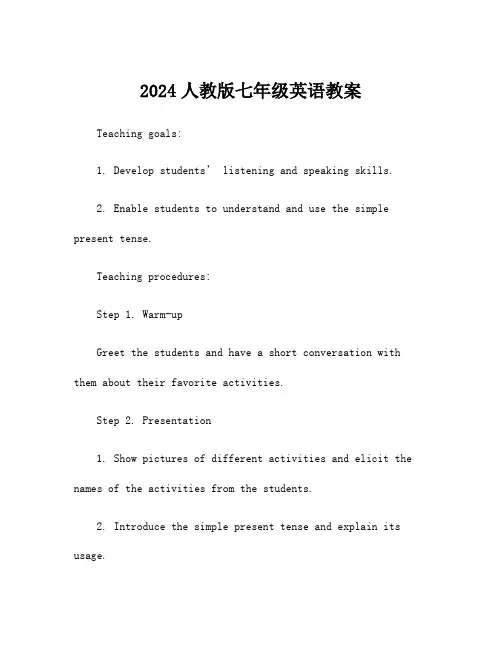
2024人教版七年级英语教案Teaching goals:1. Develop students’ listening and speaking skills.2. Enable students to understand and use the simple present tense.Teaching procedures:Step 1. Warm-upGreet the students and have a short conversation with them about their favorite activities.Step 2. Presentation1. Show pictures of different activities and elicit the names of the activities from the students.2. Introduce the simple present tense and explain its usage.Step 3. Listening1. Play the audio of the conversation between Amy and Tom about their fun day.2. Ask students to listen and answer the questions about the conversation.Step 4. Speaking1. Put students in pairs and have them role-play the conversation between Amy and Tom.2. Monitor and provide feedb ack on students’ pronunciation and fluency.Step 5. Practice1. Have students form small groups and discuss their own fun days using the simple present tense.2. Encourage students to share their discussions with the class.Step 6. SummaryRecap the usage of the simple present tense and highlight any common mistakes made by students during speaking activities.Step 7. HomeworkAssign the students exercises in the textbook related to the simple present tense.。
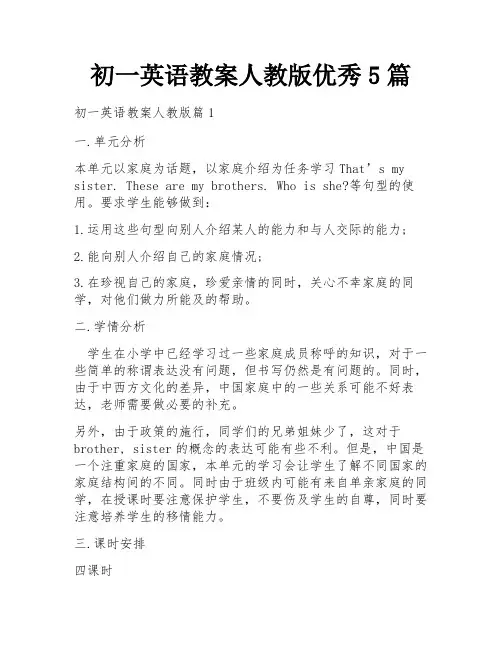
初一英语教案人教版优秀5篇初一英语教案人教版篇1一.单元分析本单元以家庭为话题,以家庭介绍为任务学习That’s my sister. These are my brothers. Who is she?等句型的使用。
要求学生能够做到:1.运用这些句型向别人介绍某人的能力和与人交际的能力;2.能向别人介绍自己的家庭情况;3.在珍视自己的家庭,珍爱亲情的同时,关心不幸家庭的同学,对他们做力所能及的帮助。
二.学情分析学生在小学中已经学习过一些家庭成员称呼的知识,对于一些简单的称谓表达没有问题,但书写仍然是有问题的。
同时,由于中西方文化的差异,中国家庭中的一些关系可能不好表达,老师需要做必要的补充。
另外,由于政策的施行,同学们的兄弟姐妹少了,这对于brother, sister的概念的表达可能有些不利。
但是,中国是一个注重家庭的国家,本单元的学习会让学生了解不同国家的家庭结构间的不同。
同时由于班级内可能有来自单亲家庭的同学,在授课时要注意保护学生,不要伤及学生的自尊,同时要注意培养学生的移情能力。
三.课时安排四课时四.教学过程Period 1 (A1, 3a, B3)I. Teaching Objectives1. Knowledge Objectives:(1) Expressions: sister, mother, father, parent, brother, grandmother, grandfather, grandparent, family, those, who, oh, these, those, they.(uncle, aunt, cousin, niece, nephew, here, photo )(2) Structure: That’s my family. Those are my parents. Who’s she? She’s my sister. Oh, and these are my brothers.3) Grammar: The plural forms of the demonstrative pronouns.2. Ability Objectives:(1) Learn how to introduce the family.(2) Get Ss to know the names of the various members ofa family.3. Moral Objectives: Father and mother, I love you!II. Teaching Importance(focus)(1) Learn how to introduce the family.(2) Get Ss to know the names of the various members ofa family.(3) Get Ss to know the differences between this/that is and these/those are.(4) Get Ss to know who questionsIII. Teaching Difficulties1. 因为单复数的问题,学生对this与these,that与those 的转换可能会弄错,2. 在拼写时,学生习惯把mother写成monther。

七年级上册英语教案人教版免费(经典版)编制人:__________________审核人:__________________审批人:__________________编制单位:__________________编制时间:____年____月____日序言下载提示:该文档是本店铺精心编制而成的,希望大家下载后,能够帮助大家解决实际问题。
文档下载后可定制修改,请根据实际需要进行调整和使用,谢谢!并且,本店铺为大家提供各种类型的经典范文,如工作总结、述职报告、策划方案、演讲致辞、合同协议、条据文书、教案资料、好词好句、作文大全、其他范文等等,想了解不同范文格式和写法,敬请关注!Download tips: This document is carefully compiled by this editor. I hope that after you download it, it can help you solve practical problems. The document can be customized and modified after downloading, please adjust and use it according to actual needs, thank you!Moreover, our store provides various types of classic sample essays for everyone, such as work summaries, job reports, planning plans, speeches, contract agreements, doctrinal documents, lesson plans, good words and sentences, complete essays, and other sample essays. If you want to learn about different sample formats and writing methods, please pay attention!七年级上册英语教案人教版免费最新七年级上册英语教案人教版免费(8篇)作为一位不辞辛劳的人·民教师,通常会被要求编写教案,那么关于七年级上册英语教案怎么写呢?以下是本店铺准备的一些七年级上册英语教案人教版免费,仅供参考。
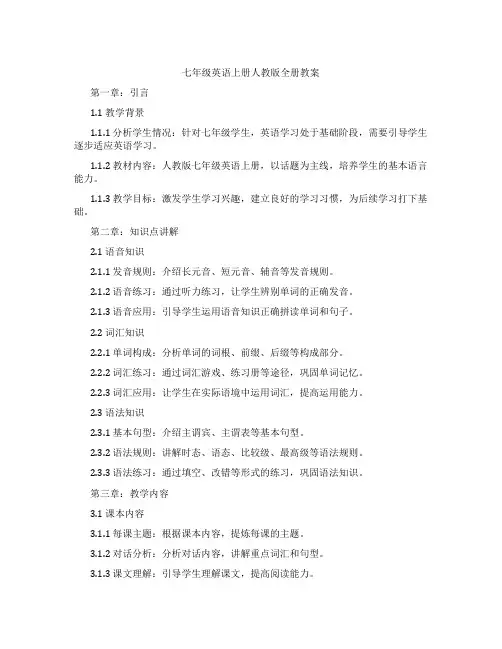
七年级英语上册人教版全册教案第一章:引言1.1 教学背景1.1.1 分析学生情况:针对七年级学生,英语学习处于基础阶段,需要引导学生逐步适应英语学习。
1.1.2 教材内容:人教版七年级英语上册,以话题为主线,培养学生的基本语言能力。
1.1.3 教学目标:激发学生学习兴趣,建立良好的学习习惯,为后续学习打下基础。
第二章:知识点讲解2.1 语音知识2.1.1 发音规则:介绍长元音、短元音、辅音等发音规则。
2.1.2 语音练习:通过听力练习,让学生辨别单词的正确发音。
2.1.3 语音应用:引导学生运用语音知识正确拼读单词和句子。
2.2 词汇知识2.2.1 单词构成:分析单词的词根、前缀、后缀等构成部分。
2.2.2 词汇练习:通过词汇游戏、练习册等途径,巩固单词记忆。
2.2.3 词汇应用:让学生在实际语境中运用词汇,提高运用能力。
2.3 语法知识2.3.1 基本句型:介绍主谓宾、主谓表等基本句型。
2.3.2 语法规则:讲解时态、语态、比较级、最高级等语法规则。
2.3.3 语法练习:通过填空、改错等形式的练习,巩固语法知识。
第三章:教学内容3.1 课本内容3.1.1 每课主题:根据课本内容,提炼每课的主题。
3.1.2 对话分析:分析对话内容,讲解重点词汇和句型。
3.1.3 课文理解:引导学生理解课文,提高阅读能力。
3.2 拓展内容3.2.1 相关话题:针对课本内容,拓展相关话题。
3.2.2 听力练习:选择合适的听力材料,提高学生听力水平。
3.2.3 口语表达:组织口语交流活动,提高学生口语表达能力。
第四章:教学目标4.1 知识目标4.1.1 掌握基本的语音、词汇和语法知识。
4.1.2 能够听懂、说出一日常用语。
4.1.3 理解课本内容,具备一定的阅读和写作能力。
4.2 能力目标4.2.1 提高学生的听、说、读、写四项基本技能。
4.2.2 培养学生的语言运用能力和团队协作能力。
4.2.3 培养学生的跨文化交际意识。
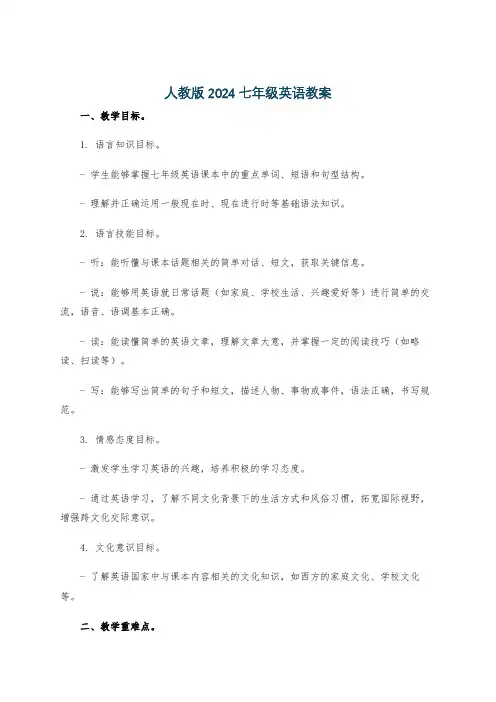
人教版2024七年级英语教案一、教学目标。
1. 语言知识目标。
- 学生能够掌握七年级英语课本中的重点单词、短语和句型结构。
- 理解并正确运用一般现在时、现在进行时等基础语法知识。
2. 语言技能目标。
- 听:能听懂与课本话题相关的简单对话、短文,获取关键信息。
- 说:能够用英语就日常话题(如家庭、学校生活、兴趣爱好等)进行简单的交流,语音、语调基本正确。
- 读:能读懂简单的英语文章,理解文章大意,并掌握一定的阅读技巧(如略读、扫读等)。
- 写:能够写出简单的句子和短文,描述人物、事物或事件,语法正确,书写规范。
3. 情感态度目标。
- 激发学生学习英语的兴趣,培养积极的学习态度。
- 通过英语学习,了解不同文化背景下的生活方式和风俗习惯,拓宽国际视野,增强跨文化交际意识。
4. 文化意识目标。
- 了解英语国家中与课本内容相关的文化知识,如西方的家庭文化、学校文化等。
二、教学重难点。
1. 教学重点。
- 重点单词、短语和句型的学习与运用。
- 基础语法知识的理解与掌握,如一般现在时的第三人称单数形式、现在进行时的构成和用法等。
2. 教学难点。
- 一般现在时和现在进行时在实际语境中的准确运用,尤其是两者的区别。
- 一些英语文化背景知识的理解与运用,如何将文化知识融入到语言学习中。
三、教学方法。
1. 情景教学法。
- 通过创设各种真实的语言情景,如家庭场景、学校场景等,让学生在情景中学习和运用英语,提高语言实际运用能力。
2. 任务驱动法。
- 布置各种学习任务,如小组对话、角色扮演、短文写作等,让学生在完成任务的过程中学习语言知识,培养合作学习能力和自主学习能力。
3. 交际教学法。
- 鼓励学生用英语进行交流互动,在交际中提高口语表达能力和跨文化交际能力。
四、教学过程。
(一)导入(5分钟)1. 播放一段与七年级英语课本主题相关的英语视频,如关于学校生活的动画片段。
2. 提问引导:- What can you see in the video?- Do you have a similar experience in your school?(二)知识讲解(20分钟)1. 单词学习。
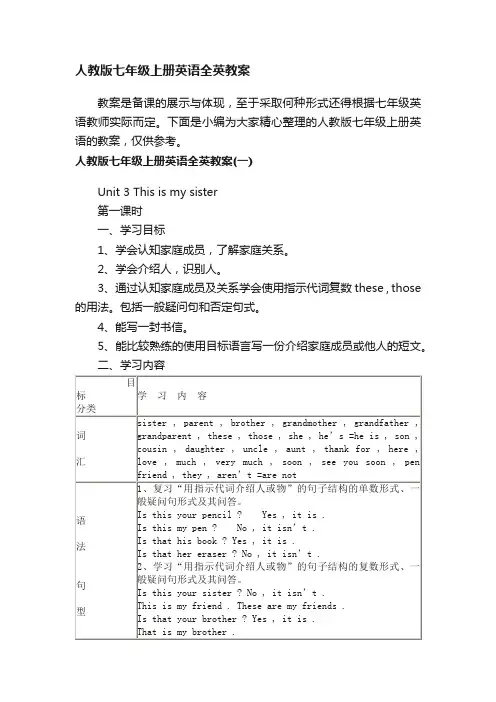
人教版七年级上册英语全英教案教案是备课的展示与体现,至于采取何种形式还得根据七年级英语教师实际而定。
下面是小编为大家精心整理的人教版七年级上册英语的教案,仅供参考。
人教版七年级上册英语全英教案(一)Unit 3 This is my sister第一课时一、学习目标1、学会认知家庭成员,了解家庭关系。
2、学会介绍人,识别人。
3、通过认知家庭成员及关系学会使用指示代词复数these , those 的用法。
包括一般疑问句和否定句式。
4、能写一封书信。
5、能比较熟练的使用目标语言写一份介绍家庭成员或他人的短文。
二、学习内容三、朗读单词1. sister n. 姐;妹2. parent n. 父或母3. brother n. 兄;弟4. grandmother n. 祖母;外祖母5. grandfather n. 祖父;外祖父6. grandparent n. 祖父/ 母;外祖父/母7. these pron . & adj.这些8. those pron . & adj.那些9. she pron .她10. he’s =he is11. son n.儿子12. cousin n.堂(表)兄弟;堂(表)姐妹13. daughter n. 女儿14. uncle n.叔;伯;舅;姨父;姑夫15. aunt n. 姨母;姑母;伯母;婶母16. thank for为……而感谢17. here adv.在这里;向这里18. love v.爱;热爱19. much adv. 很;非常20. very much 很;非常21. soon adv.不久22. see you soon ,再见。
23. pen friend 笔友24. they pron. 他(她;它)们25. aren’t =are not四、任务示范Show the Ss some pictures , point at the pictures and tell them like this :This is my father / mother / brother / sister ……That’s my sister / grandmother / grandfather ……Then ask the Ss to bring their families’ pictures and introduce people in this way .五、布置作业1、请同学们反复朗读单词,并自查能记住多少单词。
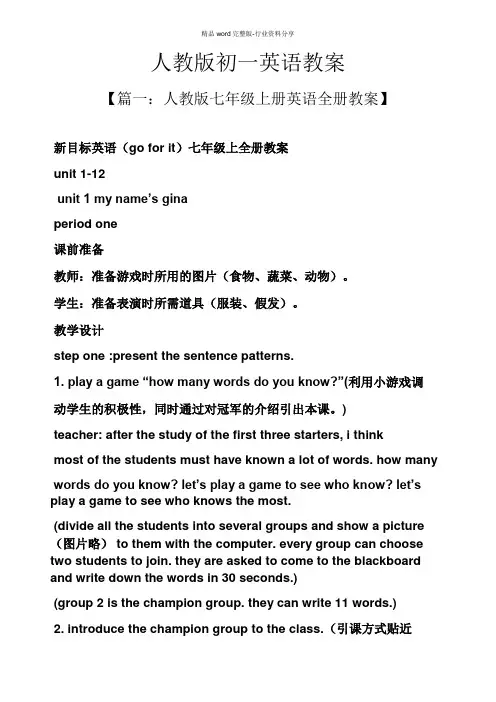
人教版初一英语教案【篇一:人教版七年级上册英语全册教案】新目标英语(go for it)七年级上全册教案unit 1-12unit 1 my name’s ginaperiod one课前准备教师:准备游戏时所用的图片(食物、蔬菜、动物)。
学生:准备表演时所需道具(服装、假发)。
教学设计step one :present the sentence patterns.1. play a game “how many words do you know?”(利用小游戏调动学生的积极性,同时通过对冠军的介绍引出本课。
)teacher: after the study of the first three starters, i thinkmost of the students must have known a lot of words. how manywords do you know? let’s play a game to see who know? let’s play a game to see who knows the most.(divide all the students into several groups and show a picture (图片略) to them with the computer. every group can choose two students to join. they are asked to come to the blackboard and write down the words in 30 seconds.)(group 2 is the champion group. they can write 11 words.)2. introduce the champion group to the class.(引课方式贴近生活,学生易于接受)teacher: congratulations, now group 2 is the champion. but i don’t know your names. would you like to introduce y ourselves to us?s1 s2:yes.s1:hello.my name is li lei. nice to meet you.ss: hello, li lei. nice to meet you ,too.ss: hello! what’s your name?s2:i’m sun ping. how do you do?ss: how do you do ?step two: drills.1. make introductions.(通过句型的操练使学生更加熟练掌握所学的句式。
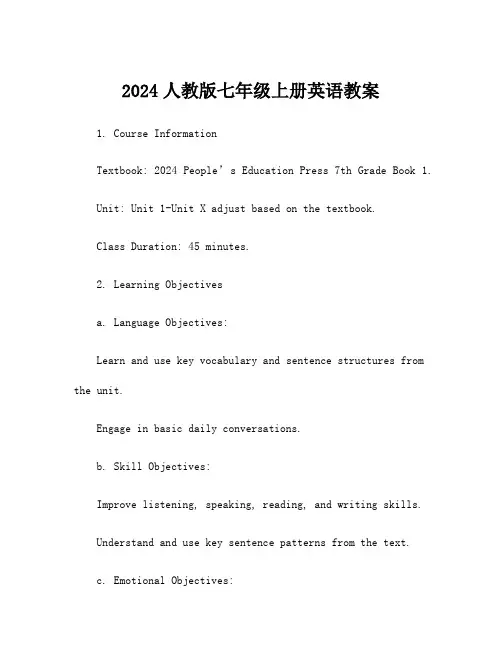
2024人教版七年级上册英语教案1. Course InformationTextbook: 2024 People’s Education Press 7th Grade Book 1.Unit: Unit 1-Unit X adjust based on the textbook.Class Duration: 45 minutes.2. Learning Objectivesa. Language Objectives:Learn and use key vocabulary and sentence structures from the unit.Engage in basic daily conversations.b. Skill Objectives:Improve listening, speaking, reading, and writing skills.Understand and use key sentence patterns from the text.c. Emotional Objectives:Foster interest and confidence in learning English.Enhance teamwork and communication skills.3. Lesson ContentText: Dialogues, short texts, and stories from the unit.Vocabulary: New words and phrases from the unit.Grammar: Key grammar points from the unit.Functional Sentences: Core sentences and expressions from the unit.4. Teaching Stepsa. Introduction (5 minutes)Use images, videos, or questions to introduce the lesson theme.Engage students and outline the learning objectives.b. New Content (15 minutes)Vocabulary: Introduce and explain new words, focusing on pronunciation, spelling, and meaning.Grammar: Explain key grammar points with examples.Sentence Patterns: Demonstrate core sentence structures and practice.c. Text Learning (10 minutes)Read the text aloud and discuss its content.Engage in group discussions or role-plays to practice dialogues.d. Practice (10 minutes)Complete related exercises such as fill-in-the-blanks, matching, and multiple-choice questions.Use group activities or games to reinforce vocabulary and sentence structures.f. Summary and Homework (5 minutes)Review the lesson’s content and address any student questions.Assign homework, such as vocabulary practice, writing tasks, or reading assignments.5. Homework AssignmentsVocabulary Practice: Complete exercises from the textbook.Writing Task: Write a short paragraph using the new vocabulary and sentence structures.Listening Exercise: Listen to recordings and complete related comprehension questions.6. AssessmentOral Evaluation: Assess student participation and performance in class.Written Evaluation: Evaluate homework and exercise accuracy.7. ReflectionReflect on the effectiveness of the lesson based on student feedback and observation.Note areas for improvement for future lessons.。
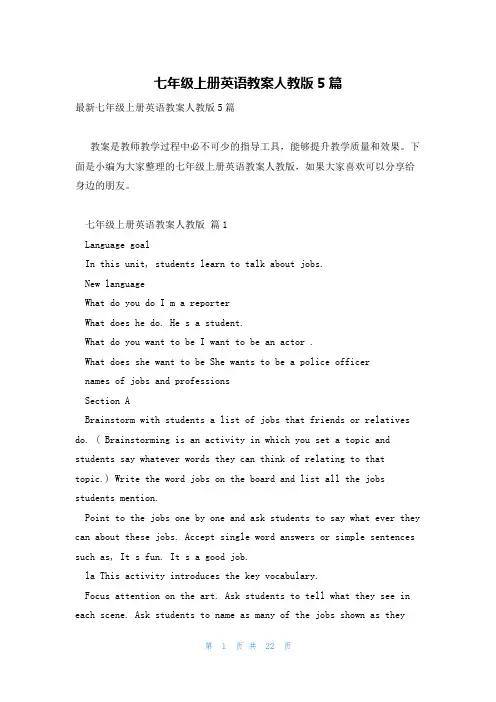
七年级上册英语教案人教版5篇最新七年级上册英语教案人教版5篇教案是教师教学过程中必不可少的指导工具,能够提升教学质量和效果。
下面是小编为大家整理的七年级上册英语教案人教版,如果大家喜欢可以分享给身边的朋友。
七年级上册英语教案人教版篇1Language goalIn this unit, students learn to talk about jobs.New languageWhat do you do I m a reporterWhat does he do. He s a student.What do you want to be I want to be an actor .What does she want to be She wants to be a police officernames of jobs and professionsSection ABrainstorm with students a list of jobs that friends or relatives do. ( Brainstorming is an activity in which you set a topic and students say whatever words they can think of relating to that topic.) Write the word jobs on the board and list all the jobs students mention.Point to the jobs one by one and ask students to say what ever they can about these jobs. Accept single word answers or simple sentences such as, It s fun. It s a good job.la This activity introduces the key vocabulary.Focus attention on the art. Ask students to tell what they see in each scene. Ask students to name as many of the jobs shown as theycan. Then point to a scene, name the job, and ask students to repeat. Point to the numbered list of words. Say each one and ask students to repeat.Then ask students to match each word wllfa one of the scenes. Say, Write the letter of each scene next to one of the ivords. Point tothe sample answer.1 b This activity gives students practice in understanding thetarget language in spoken conversation.Point to the different people shown in the picture.Ask various students to tell what they do as you point to each one,Say, Now you will hear three conversations. The conversations are about three of the people in this picture.Play the recording the first time. Students only listen.Play the recording a second time. This time ask students to write a number 1 next to the person being talked about in conversation 1. Have students put a 2 and 3 next to the people being talked about in conversations 2 and 3.Correct the answers.1 c This activity provides guided oral practice using the target language-Ask a student to read the example conversation with you. Hold upthe book and point to the doctor in the picture.Say, Now work with your partner. Make your own conversations about the picture. You can use sentences like the ones in activity 1b.Say a dialogue with a student. Point to a picture of one of the people. Guide the student to answer using one of the words inactivity 1a.As students work in pairs, move around the room monitoring theirwork. Oner language or pronunciation support as needed.2a This activity gives students practice in understanding thetarget language in spoken conversation.Ask students to look at the three pictures. Ask different students to tell you what they sec in each picture. What are the people doing What jobs do they havePlay the recording the first time. Students only listen.Say, You will hear conversations about the people in these pictures.Play the recording a second time. Say, Write the number of each conversation below the picture of the person being talked about.Correct the answers.2b This activity gives students practice in understanding thetarget language in spoken conversation.Point to the three headings in the chart and read the headings to the class. Ask students, What does wants to be mean (It is not the Job the person lias now. It is the job the person wants in the future.)Play the recording the first time. Students only listen.Say, You wiU hear about the people in these pictures. You will hear the job they haw now and the job they want in the future.Play the recording a second time. This time ask students to fill in the blanks with the jobs the people have now and the ones they wantin the future. Point out the sample2c This activity provides guided oral practice using the target language.Point out the pictures in activity 2a. Ask who each person is. (They are Susan s brother. Anna s mother, and Tony s father.)Say, Now work with your partner. Ask and answer questions about thepictures. Ask, What does he or she do Then ask, What does he or she want to beSay a dialogue with a student. Point to Anna s mother and then to the example in the speech balloons. Practice the dialogue with a student.As students work In pairs, move around the room monitoring their work. Offer language support as needed.3a This activity introduces the names for the places where people work, and gives reading practice using the target language.Call attention to the pictures. Ask students to read the name for each place. As they name each place, write the word on the board and-ask the class to repeat it.Point out the list of jobs with the numbers next to each. Then call attention to the people in the pictures and the speech bubbles. Point out the sample answer and have a student read out the speech bubble. Ask students to work alone. Say, Write the number of each job in the square next to each workplace.Check the answers.3b This activity provides guided oral practice using the target language.Point out the pictures in activity 3a. Ask students to name the workplace shown In each picture.Then point out the conversation in the speech bubbles. Ask two students to read It to the class.Say, Wow work with a partner. First practice the conversation in the picture. Then make new conversations. Use jobs and places from activity 3a.Say a dialogue with a student. Point to the word waiter in activity3a and then to the picture of the restaurant. Ask a student. Where does he work Guide the student to answer using the correct place: He works in a restaurant.Then ask. What does he do and guide the student to answer, He s a waiter.As students work in pairs, move around the room monitoring their work. Offer language support as needed.4 This activity provides listening and speaking practice using the target language.Call attention to the pictures in the book showing how to play the game. Say, You will draw a picture of someone working. Other students will ask questions about the kind of job you are drawing. After two questions someone can try to guess the job.Demonstrate by drawing a picture on the board of a stick figure reporter. Add details (microphone, notebook,etc.) until students guess what job it is.Ask a student to go to the board. Say, Draw a picture of a person working. If necessary, help the student add details that show the job the person is doing. He or she can add a bank interior to show that the person is a bank clerk. A student could also use an eye chart on the wall to show that the place is a doctor s office and the personis a doctor.Ask two different students to ask questions about the Job, and then ask a third student to guess what job it is.Play the game using drawings by several different students.Alternative: If you do not want students to move from their seats, then you can ask them to do this activity sitting down in groups of four. They will need pieces of paper on which to draw their pictures. They will also need pencils.Section BNew languageWords that describe jobs, such as exciting, dangerous,boring, difficult, busy, funAdditional materials to bring to class:help wanted ads from an English-language newspaper1 a This activity introduces the key vocabulary.Focus attention on the six pictures. Ask, What job does the person have Where does the person ivnrkPoint out the numbered list of words. Say each one and ask students to repeat. Then use simple explanations and short sample sentences to help students understand what each word means. For example, Exciting means very interesting and very fast-moving. A police officer has an exciting job. The job is always changing. Something is always happening. For dangerous you might say, Dangerous means not safe. You might be hurt or killed in a dangerous job.Then ask students to match each word with one of the pictures. Say, Write the letter of each picture next to one of the words. Point out the sample answer.Check the answers.1 b This activity provides guided oral practice using the target language.Call attention to the picture In this activity and ask a student to read the statement to the class. Then point to the picture of the police officer and say. It s an exciting job. Ask the class to repeat. Then say, What else can you say about being a police officer Someone may answer, It s a dangerous job. Ask the class to repeat each correct answer.Then ask students to work in pairs. Suggest that they each point to the pictures of the workers and make statements about them. As students practice, move around the classroom monitoring their work.1 c This activity provides an opportunity for oral practice.Say, Name some of the jobs from this unit. Write this list of jobs on the board. Say, Can you name some other jobs Add any new jobs to the list.Ask some students to make statements about Jobs on the list using the words in activity la. You may wish to write some of the sentences on the board so that students can copy the sentences into their notebooks.2a This activity provides listening and writing practice with the target language.Call attention to the two headings and ask a student to read die headings to the class.Point out the blank lines where students will write the name of a job (under the words wants to be).Play Ihe recording the first time. Students only listen.Say, Now I will play the tape again. This time write the name of a job under the words wants to be.2b This activity provides listening and writing practice with the target language,Call attention to the second heading and ask a student to read it to the class. Say, This time you will unite why each person wants the job.Play the recording again. Students only listen.Then say, Now I will play the tape again. This time write the reason the person wants the job under the word WhyPlay the recording. Students write their answers.Check the answers.2C This activity provides open-ended oral practice using the target language.Say, What do you want to be What words describe each job Help the class make up a list of jobs they might like to do. As students suggest possible jobs, ask the class to suggest words to describe them. Use a bilingual dictionary, if necessary, to find the names of jobs and words to describe each one.Then ask students to work in small groups. They tell each otherwhat they want to do and why. Encourage students to use dictionariesif necessary. Move from group to group offering assistance as needed. Ask individual students to tell the class about what they want tobe and why.3a This activity provides reading and writing practice using the target language.Call attention to the three newspaper ads and read these ads to the class. Say blank each time you come to a blank line.Then read each ad again separately, pausing to allow students toask questions about anything they don t understand. For example, in the first ad, students may not know that working late means workingat night. To work hard means to use a lot of energy to do the job.Ask students to fill In (he blanks in the ads using the words actor, reporter, and waiter.Check the answers.3b This activity provides reading and writing practice using the target language.Call attention to the newspaper ad and ask a student to read it,saying blank for each blank line.Ask students to fill in the blanks using words from This section. Say,Look at the pictures next to each blank line. The pictures will help you guess the correct word.Suggest that they look at the names of jobs and the words that describe jobs in the first part of Section B.Check the answers,3c This activity provides writing practice using the targetlanguage.Point out the blank strip of newspaper where students can write their own ads.Ask one or two students, What are you going to write about Repeat each of the students sentences and ask the class to repeat the sentences after you. For example: Do ^OM want an interesting but dangerous job Do you want to meet new people We need a police officer.Call the Smithtown Police Station at 555-2323.Ask students to read their ads to a partner. Ask the pairs to correct each other s work.4 This activity provides guided oral practice using thetarget language.Ask two students to read the conversation in the speech bubbles. Answer any questions students may have about it.Then say, New please work in groups. Ask efuestions to find out what jobs each person wrote about. You can use sentences like the ones we just read.As students ask questions, move from group to group. Rephrase any incomplete or incorrect questions.Also rephrase any inaccurate answers.七年级上册英语教案人教版篇2Unit 3 Language in use课型 Revision and application教材分析 Unit 3 对“自我介绍和获取信息”的功能句式进行综合训练:谈论自己或朋友的情况(活动1);根据提示完成介绍图片中人物情况的句子;填表、匹配复习表示国家、民族及人物活动的词汇。
人教版初中英语优质教案精选10篇人教版初中英语教案篇一一、教材分析本课是本单元的中心课文,主要以“邀请”这个话题为主线,电话交际为辅线来展开教学活动,讨论距离(befarfrom),请求许可(MayI??Yes,,youmaynot.),表明意图(Iwantto?)中展开教学活动。
二、学情分析学生已学习了打电话用语和MayI?句型,为学习本课做好了铺垫。
三、教学目标1.帮助学生掌握并灵活运用本课的重点词汇、短语、句型2.帮助学生掌握语言技能知识,熟练使用电话用语和邀请的日常交际用语,正确表达与本课有关的Distance、Permission、Intentions内容。
3.让学生感受勇敢地开口与同学交流合作的快乐。
四.教学重点难点1.1.词汇:want,e,hello,with,who,when,do,leave,for,arrive2.2.短语:leaveforarrivein/attalkto/with3.3.句型:1).wantsomebodytodosomething2).invitesomebodytosomewhere3).Thanksfor?五、教学方法创设情境、小组演练、仿编对话六、教学媒体MultimediaRecorderandTape七、教学过程Step1RevisionandLead-in1.帮助学生创设情境编演一个小对话,让他们四人一组模仿编演:A:MayIplaypingpongnow?B:No,youmaynot.A:MayIdomyhomeworknow?B:Yes,youmay.2.告诉学生李明想请Jenny和Danny一起去北京,该如何对父母说,让学生试编一个小对话,由此导入新课。
Step2FastReading八.板书设计。
(BlackboardDesign)Words&phrasesiinvitesomebodytodosomething邀11.leave离开请某人去做某事leave?for离开某地去某地invitesomebodytoaplace邀请某leavefor动身去某地人去某地2.arrivein/at到达大/小地方6.6.CanadaisfarfromChina.Is3.talkto/with和某人交谈CanadafarfromChina?4.want想要7.wanttodosomething想事wantsomebodytodosomething想要某人去做某事5.invite邀请九.教学反思1.导入环节很顺利,效果较好。
人教版七年级英语优秀教案五篇写一份优秀教案是设计者教育思想、智慧、动机、经验、个性和教学艺术性的综合体现。
写好一份优秀的英语教案不容易,下面就是小编整理的七年级英语优秀教案,希望大家喜欢。
七年级英语优秀教案1Topic 1 I have a small nose.Section AThe main activities are 1a, 2a and 3a. 本课重点活动是1a, 2a和3a。
Ⅰ.Teaching aims and demands 教学目标1.Learn some new words:(1)Learn words about parts of the body:nose, eye, head, face, hair, ear, mouth, neck(2)Learn some other new words:guess, have, small, has, big, know, right, round, long, wide, girl, boy, short2. Learn some useful sentences:(1)Oh, I know.(2)Yes, you’re right.3. Learn the simple present tense with“have/has”and adjectives of description:(1)I have a big nose.(2)They have round faces.(3)She has long hair.(4)It has big ears.4. Learn how to describe people’s appearances.Ⅱ. Teaching aids 教具小黑板/影片的封面或图片/教学挂图/录音机Ⅲ. Five-finger Teaching Plan 五指教学方案Step 1 Review 第一步复习(时间:10分钟)通过复习,培养学生根据图画和文字信息进行简单交流的能力。
人教版7上英语教案5篇(实用版)编制人:__审核人:__审批人:__编制单位:__编制时间:__年__月__日序言下载提示:该文档是本店铺精心编制而成的,希望大家下载后,能够帮助大家解决实际问题。
文档下载后可定制修改,请根据实际需要进行调整和使用,谢谢!并且,本店铺为大家提供各种类型的实用资料,如工作计划、汇报材料、心得体会、发言稿、合同大全、申请书、演讲稿、作文大全、教案大全、其他资料等等,想了解不同资料格式和写法,敬请关注!Download tips: This document is carefully compiled by this editor.I hope that after you download it, it can help you solve practical problems. The document can be customized and modified after downloading, please adjust and use it according to actual needs, thank you!Moreover, our store provides various types of practical materials for everyone, such as work plans, presentation materials, reflections, speech drafts, contract summaries, application forms, speech drafts, essay summaries, lesson plans, and other materials. If you want to learn about different data formats and writing methods, please stay tuned!人教版7上英语教案5篇教案的实施需要教师具备良好的组织和管理能力,以确保教学过程的顺利进行,编写详细的教案可以帮助我们更好地运用各种教学方法和策略,提高教学的多样性,以下是本店铺精心为您推荐的人教版7上英语教案5篇,供大家参考。
七年级英语上册全英文教案(全册)Unit 1 My name's Gina.一、单元教材分析本单元围绕“结交新朋友”使学生学会打招呼和介绍自己、询问他人姓名的基本句型:“What’s your/his/her name?My/His/Her name is …”; 通过学习区分"First/last name”,了解有关姓名的文化知识;通过查询电话号码“What’s your/her/his phone number?”,学习数字1~9,同时也进一步促进学生之间的相互了解;通过以上几个方面的学习,使学生在轻松、愉快的学习氛围中熟识新伙伴。
本单元与第二单元衔接紧密:由课堂内的打招呼、自我介绍到课外、校外相互了解。
由特殊疑问句的学习到一般疑问句的学习,使学生将书本知识运用到实际生活中。
二、单元学情分析本单元的主题是熟识新伙伴,同时引导学生采用Practicing, Listening for specific information和Role playing的学习策略,学习一些新词汇,掌握一些重点句型,在小组合作学习的过程中,进一步促进学生之间的相互了解。
三、单元教学建议本单元可综合运用讲授式、启发式、自主学习、合作学习等各种策略,提供大量的学习资源,通过老师向学生进行的自我介绍,同学自我介绍传句子比赛,自我查资料表演,自制明信片等的活动,使学生能够学到知识,又增加了他们的学习的乐趣。
来培养学生的自主学习的能力及表达能力和逻辑思维能力。
采用Practicing, Listening for specific information和Role playing的学习策略,利用教学图片或制作多媒体课件来展开课堂Pair work, Group work的口语交际活动,询问他人姓名、查询电话号码,了解有关姓名的文化知识。
四、单元课时分配本单元可用4课时完成教学任务:Section A (1a-2d) 用1课时Section A (Grammar Focus-3c) 用1课时Section B (1a-2c) 用1课时Section B (3a-Self Check) 用1课时Section A (1a-2d)一、教学目标:1. 语言知识目标:1) 能掌握以下单词:name nice meet his and her your能掌握以下句型:① —Hi. My name’s Gina. —I’m Jenny. Nice to meet you!① —What’s your/his/her name? —My/his her name is…① —Are you…? —Yes, I am. / No, I'm not.① —Is he/she…? —Yes, she/he is. / No, she/he isn’t.2) 能了解以下语法:your, his, her等形容词性物主代词的简单用法;What’s=what is I’m=I am name’s=name is等缩写形式。
人教版七年级上册英语教案16篇人教版七年级上册英语教案(精选篇1)一、复习指导思想新授课结束后,期末考试前,指导学生进行期末复习,主要复习基础知识,提高做题能力,训练阅读、听力与写作,使学生能够举一反三,熟练掌握知识点与考点.二、学生学习水平现状分析学生的主要问题是基础薄弱,做题能力参差不齐,优秀的学生不多,成绩有待于提高的学生比较多,一部分同学学习惰性强。
三、复习时间:十七周至十八周(共10课时)四、复习重点1、基础知识:unit1—unit8:重点词汇、短语、句型2、语法:(1)动词不定式(2)动名词(3)被动语态(4)形容词相关句型的运用(5)副词的运用(6)原因状语从句(7)过去进行时3、阅读训练(报纸阅读材料)4、听力(报纸、导学案套题听力训练)5、话题写作:肢体语言,义务工作,传统技艺,卡通漫画、动物保护、动物描写、未来生活畅想6、复习中注重讲练结合,及时反馈,及时检测五、课时安排时间为两周,具体计划如下:十七周(周一)unit1、2重点词组句型小结;语法训练(报纸2、3版)十七周(周二)unit1、2知识点练习,话题写作训练(报纸4版)十七周(周三)unit3、4重点词组句型小结;语法训练(报纸5、6版)十七周(周四)unit3、4知识点练习,话题写作训练(报纸7版)十七周(周五)unit5、6重点词组句型小结;语法训练(报纸8、9版)十八周(周一)unit5、6知识点练习,话题写作训练(报纸10版)十八周(周二)unit7、8重点词组句型小结;语法训练(报纸11、12版)十八周(周三) unit7、8知识点练习,话题写作训练(报纸13版)十八周(周四)模拟套题(报纸31版)(综合测试一)十八周(周五)模拟套题(报纸32版)(综合测试二)六、复习措施1、单词过关。
每天重点句子听写2、语法复习注重讲练结合,引导学生说出重点与易错点3、加强整理英语学习档案4、对于阅读训练有指导,有检测。
人教版英语七年级教案5篇人教版英语七年级教案1教学目标Teaching aims (教学目标)1. 学习祈使句的否定形式。
2. 学会使用祈使句表示规则。
3. 能够熟练使用can和can’t表示许可。
4. 能和同学谈论校规。
教学重难点Language points (语言点)1. 词汇:1)名词n. rule, hallway, hall, fight2) 动词v. arrive, listen, fight, wear3) 形容词 adj. sorry, outside4) 词组 be on time, dining hall, listen to…2. 句型:What are the rules? We can’t …./Don’t …/We have to …Can we … ? Yes, we can./No, we can’t.What do you have to do? We have to …Difficulties (教学难点)1.祈使句的否定形式。
2. 如何谈论规则。
教学过程Teaching steps (教学步骤)1. Warm-up and revision(课堂热身和复习)(1)Greet the class.(2) Listen to a song.T: Do you like this beautiful song?Can we listen to it in class?T: Can we listen to music in the classroom?What can we do in the classroom?What can’t we do in the classroom?【教学设计说明】通过听歌曲来导入本单元的主要话题——规则。
让学生自由谈论在教室里可以做的事情和不可以做的事情,帮助学生培养秩序感。
2. Presentation (呈现新知识)(1) Present the new words: classroom, hallway, dining room, fight, arriv e late for class.Show some pictures of the new words on the screen. Have Ss read these words.classroom, hallway, dining room, fight, arrive late for class(2) Flash some pictures quickly on the screen. Have Ss say the words according the pictures as quickly as they can.(3) Show some pictures of different activities that are happening in the school.Help Ss understand the school rules.T: Can you run in the hallways? Don’t run in the hall ways.T: Can you fight? Don’t fight.T: Can you listen to music in class? Don’t listen to music in class.T: Can you eat in the classroom? Don’t eat in the classroom.You can only eat in the dining hall.T: Can you arrive late for class? Don’t arrive late for class.You must be on time.【教学设计说明】图片教学法是呈现新知识最简单有效的方法之一,学生通过图片,能更价值观的理解新单词的含义。
人教初一英语教案人教初一英语教案:定语从句:(一)基础:引导词---who, which, that, whom,练习1.I like cities___________are quiet and clean. 2.I prefer students _________are hard- working.3.I hate TV shows _________ are noisy and boring.4.The music __________ is gentle and quiet attracts me a lot.5.The food __________tastes delicious is not always healthy.6.Those boys ___________ are playing basketballs over there are from Class Fifteen.7.The books ____________ are written by Lu Xun are worth reading.8.The town ___we visited last week is much larger than before.9.The book ___ he bought is very interesting.(二)特例:只用that的情况1先行词被___________或___________所修饰,或本身是______________________时,只能用that,2.被修饰的先行词为________________________________________________等不定代词时, 只能用that.3.先行词被_____________________________________________等词修饰时,只能用that,而不用which。
4.先行词里同时含有______________________,如I can remember well the persons and some pictures that I saw in the room.5. 以______________________引导的特殊疑问句,只能用that.如:Who is the girl that is crying?练习1. I am interested in everything___ is about the 2006 World Cup.2. Isthere anything___I can do for you? 3. This is the very bike ______I lost4.To my surprise, he gave me nothing __ I need. 5.This is the best dictionary __ I have ever used.6. He was the first person _______passed the exam.7.He talked happily about the men and books________interested him greatly.(三)whose 1. The student ______father works in the factory is sitting there.2. I like the rooms ______windows face south.3. This is the desk ______legs were broken.4The woman ___ umbrella you took is angry about it.5.Here comes a girl ___ handwriting is the best .6The banana __skin is green cant be eaten.7That tall tree _ leaves are yellow is very old.(四)从句谓语单复数由先行词确定,时态由从句时间状语决定,不必跟主句保持一致。
1-He is one of the boys who ____ (doesnt, dont) finish doing homework.2-I like films which ____(be) exciting and interesting.3-Children who often ____(eat) junk food are easy to become fat and unhealthy.4-That boy who _____(run) fastest is from our class.5Those boys who ____ playing the guitar are from our school. (be)6The trees which _____ (be) watered yesterday belong to them. 7The man who ____ over there is our teacher.(stand) 8Those boys who ____ playing the guitar are from our school. (be)9Mr. Brown is one of the foreign experts _______ _________ (work) in China.10Im one of the boys ______ ________(like) English best.(五)介词+关系代词注意:介词的选用要考虑:A.与先行词的搭配关系1)I will never forget the day __________ I joined the army.2) I will never forget the days ______ I worked here.3) I will never forget the year ____________ my son went to college.B. 与谓语动词的搭配习惯1)Have you found the book ________I paid 29 dollars?2)Have you found the book ________I spent 29 dollars?3) Have you found the book _____________we learnt a lot?4) Have you found the book _______she often talks?关系副词的用法练习:1. It must be a good place ________________we can do a lot of exercise.2.This is the village _________________we visited last week.3.The house _______ we live in is very big./ The house _______ we live is very big4. The woman ___________ talked to you just now is a doctor. The woman ______ you talked to is my sister. The woman to ___________ you talked is my sister. 5. This is the hospital ____________ I was born in. This is the hospital in _________I was born. This is the hospital____________ I was born. 综合练习一. 用适当的关系代词或关系副词填空1. The boy ______ is wearing the black jacket is very clever.2. This is the present ____he gave me for my birthday.3.The man _______ talked to you just now is an engineer.4. He talked about the teachers and schools _______ he had visited.5. There is nothing in the world ______can frighten him.6. We visited a factory _______makes toys for children.7. Is this the place _______ your fatheronce lived 8. Ill never forget the days _______ I joined the League.9The car______my father bought last month is beautiful.10The man______hair is white is his grandfather.二( )1.Rosa likes music ___ is quiet and gentle. A. when B. that C. where D. who( )2.--Is the girl _ is interviewing the manager of that company your friend--Yes, she is a journalist from CCTV.A. whom B. which C. who D. whose( )3 Yao Ming is a famous basketball star ___ is playing in the NBA. A. whose B. who C. what D. which( )4. The doctor ___I am waiting for is Mr. Smith. A. which B. whom C. whose D. why( )5. --- Do you know Hong Zhanhui? ---Yes. Hes the college student ____ has moved Chinese people a lot.A. who B. which C. what D. whom ( )6. In my family, my sister is the only person __ loves chocolate. A. which B. who C. whom D. she( )7. This is the place ____ the old man lived last year. A. when B. where C. that D.which( ) 8. The song ___ Jay Zhou sings are popular with students.A. whyB. whomC. whatD. which ( )9. The farmer was very thankful to the doctor ___ treated his son. A. what B. which C. who D. whose( )10.I like to live in a house__ is big and bright. A. that B. who C. how D. why( )11. The young lady ___ we met yesterday is our new math teacher. A. what B. whose C. whom D. which( )12. --Can you introduce the town to me? --OK. This is the town in __ I was born. A. that B. who C. which( )13. Miss green is the only person __ can help you withyour English. A. she B. whom C. which D. who( )14. I like the second football match ___was held last week. A. which B. who C. that D. /( )15. Is there anything ____ to you? A. that is belonged B. that belongs C. that belong D. which belongs( )16. I hate people ___ dont help others when they are in trouble. A. who B. which C. they( )17. This is the only book ___I am looking for. A. that B. which C. who D. whom( )18 Her sister__ you met at my home was a teacher of English. A. whom B. that is C. which D. who is( )19 The book__is sold out at the moment. A.you need Bwhat you need C.which you need it D that you need it( )20 Im one of the boys ______never late for school. A. that is B. who are C. who am D. who is( )21.__cleans the classroom can go home first. A. Anyone B. Those who C. However D. The one who( )22. The old man __yesterday is a scientist.A.I spoke B. I spoke to C. whom I spoke D. that I spoke to him中考定语从句真题演练 1.---Is the girl __ is interviewing the manager of that company your friend? --Yes, she is a journalist from CCTV. A. whom B. which C. who D. whose2. Do you still remember the movie _____ we saw last weekend? A. who B. what C. that D. whom3. ---Who is your new English teacher? ---Elena, the woman ____ is wearing a red T-shirt over there.A. 不填 B. whom C. whose D. who4. Is that the man _____ helped us a lot after the earthquake? A. whose B. which C. when D. who5. ---What are youlooking for? --- Im looking for the pen ___ I bought yesterday. A. who B. which C. whose6. This is the novel_____ written by Guo Jingming. A. who B. what C. that D. /7. We should be ready to help the people ____ are in trouble. A. whose B. whom C. which D. who8. Two years has passed, but Chinese people still remember those exciting days ____ they spent during the Beijing 2021 Olympic Games. A. that B. who C. when9. The magician _____ played magic tricks in 2021 CCTV Spring Festival Gala is Liu Qian. He is popular in China now. A. whose B. who C. which10. July likes music very much. She likes music ____ she can dance to. A. what B. who C. that11. At school, you should do the things _____ are allowed by the teachers. A. that B. when C. what12. Thought is the key _____ opens the doors of the world. A. why B. where C. which D. who13. The gentlemen ___ are coming to my office tomorrow are my classmates many years ago.A. whom B. who C. those D. which14. Thats the man _____ house was destroyed in the storm. A. that B. whose C. who D. which15. The girl ____ I just talked with is Bens sister. A. whom B. which C. she 16. I love people ____ are friendly to others. A. which B. whose C. what D. who17. Its time to say goodbye to my school. Ill always remember the people _____ have helped me.A. who B. what C. which D. where18. I like the teacher ____ classes are very interesting and creative. A. which B.who C. what D. whose19. Do you know the boy ____ is sitting next to Peter? ---Yes. He is Peters friend. They are celebrating his ____ birthday.A. who, ninthB. that, ninethC. /, ninethD. which, ninth20.ShaolinTemple__lies in the west of Zhengzhou welcomes the visitors from abroad.A.where B.which C.who二宾语从句1宾语从句的学习要注意三个方面第一:语序:在宾语从句中,一律用___________。